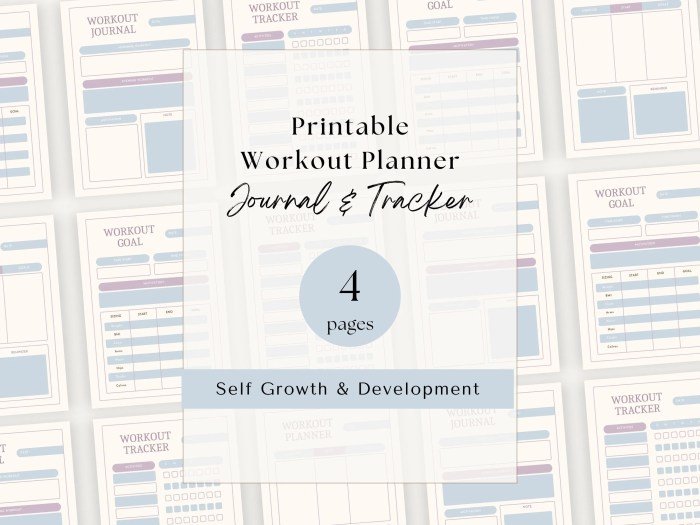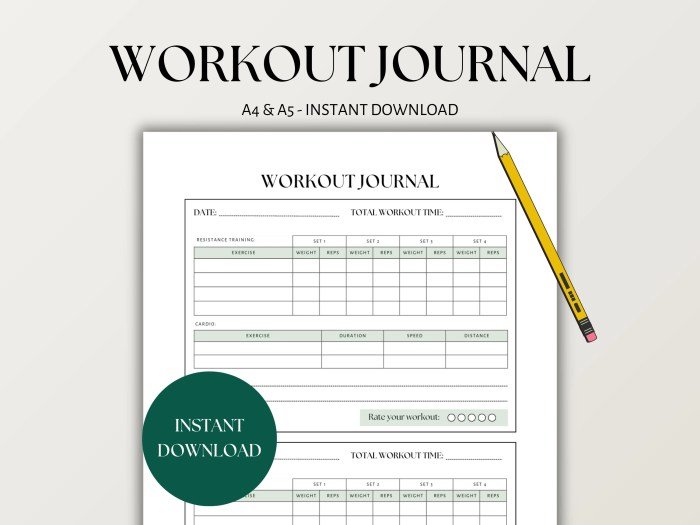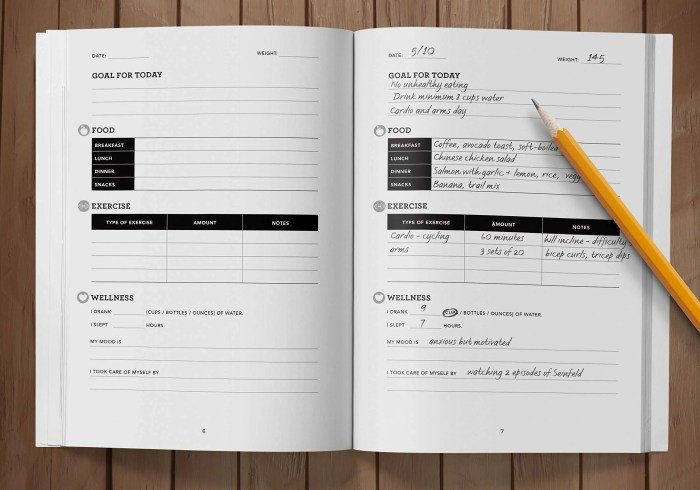Fitness journaling is a powerful tool for anyone looking to improve their health and well-being. It provides a structured way to track your progress, set goals, and stay motivated on your fitness journey. By recording your workouts, nutrition, and other relevant data, you can gain valuable insights into your body’s responses and make informed decisions about your training and lifestyle.
Fitness journals come in various forms, from traditional paper notebooks to digital apps and online platforms. The key is to find a method that suits your preferences and allows you to consistently track your progress. Whether you’re a seasoned athlete or just starting your fitness journey, fitness journaling can be an invaluable tool for achieving your goals and living a healthier life.
What is Fitness Journaling?
![]()
Fitness journaling is a powerful tool for anyone seeking to improve their health and fitness. It involves tracking your workouts, nutrition, sleep, and other aspects of your lifestyle to gain valuable insights into your progress and identify areas for improvement.
Benefits of Fitness Journaling
Keeping a fitness journal offers numerous benefits that can contribute to your overall well-being.
- Increased Accountability:Regularly documenting your fitness activities can motivate you to stay consistent with your goals. Knowing that you’ll be tracking your progress can make you more likely to stick to your workout schedule and healthy eating habits.
- Enhanced Self-Awareness:By recording your workouts, nutrition, and other lifestyle factors, you gain a deeper understanding of your body’s responses to different activities and dietary choices. This awareness can help you make informed decisions about your fitness journey.
- Improved Progress Tracking:Fitness journals provide a clear record of your progress over time. This allows you to see how far you’ve come, celebrate your achievements, and identify areas where you might need to make adjustments.
- Goal Setting and Motivation:Setting specific fitness goals and tracking your progress can provide a sense of purpose and motivation. Seeing your progress documented in your journal can reinforce your commitment to achieving your objectives.
- Problem Identification:By tracking your fitness activities, you can identify patterns and potential issues that may be hindering your progress. For example, you might notice that you’re consistently struggling with a particular exercise or that your energy levels are low on certain days.
This information can help you address these challenges and improve your performance.
- Improved Communication with Professionals:If you’re working with a personal trainer, nutritionist, or other healthcare professional, a fitness journal can provide valuable insights into your progress and help them tailor their recommendations to your specific needs.
Types of Fitness Journals
There are various ways to keep a fitness journal, catering to different preferences and technological comfort levels.
- Paper Journals:Traditional paper journals offer a tangible and personal way to record your fitness journey. They allow for handwritten notes, drawings, and personal reflections, making them a more intimate and reflective experience.
- Digital Journals:Digital fitness journals, often in the form of spreadsheets or online platforms, provide a convenient and organized way to track your data. They allow for easy data entry, analysis, and sharing with others.
- App-Based Journals:Numerous fitness apps offer built-in journaling features, allowing you to track your workouts, nutrition, sleep, and other metrics. These apps often provide additional features such as personalized insights, progress reports, and community support.
Components of a Fitness Journal

A fitness journal is a powerful tool for tracking your progress, understanding your body, and achieving your fitness goals. It’s a personalized record of your workouts, nutrition, and overall well-being, providing valuable insights that can help you stay motivated and make informed decisions.
Fitness journaling can be a powerful tool for tracking progress, identifying patterns, and staying motivated. Whether you’re a seasoned athlete or just starting your fitness journey, keeping a record of your workouts, nutrition, and overall well-being can be incredibly beneficial.
For those in the Boerum Hill area, consider checking out blink fitness boerum hill as a convenient and affordable option for your fitness goals. Once you’ve found a gym that suits your needs, make sure to incorporate journaling into your routine to maximize your fitness journey.
Essential Components of a Fitness Journal
The key elements of a fitness journal should provide a comprehensive overview of your fitness journey. These elements should be tailored to your individual needs and goals, but a well-rounded journal typically includes the following:
- Workout Log:This section documents your training sessions, including the date, time, exercises performed, sets, reps, weight, and any other relevant details.
- Nutrition Tracking:This component allows you to record your daily food intake, including meal times, portion sizes, and the types of food consumed. It can help you identify potential nutritional deficiencies or excesses.
- Progress Tracking:This section monitors your physical progress, such as weight, body fat percentage, strength gains, and endurance improvements. It helps you visualize your achievements and identify areas where you might need to adjust your approach.
- Sleep Monitoring:Adequate sleep is crucial for recovery and performance. Tracking your sleep patterns can reveal any potential sleep disruptions and help you prioritize sleep for optimal fitness.
- Body Composition Analysis:Tracking body composition metrics, such as lean mass and fat mass, provides a more accurate picture of your fitness progress than weight alone.
- Mental and Emotional Well-being:This section allows you to reflect on your mental state, motivation, and overall well-being. It helps you identify potential stressors or challenges that might be impacting your fitness journey.
- Goals and Reflections:This component Artikels your fitness goals, both short-term and long-term. It also provides space for you to reflect on your progress, identify areas for improvement, and adjust your goals as needed.
Designing a Fitness Journal Template
A well-structured template can make journaling more efficient and effective. Here’s a sample template that incorporates the essential components:
| Date | Workout | Exercises | Sets/Reps/Weight | Duration | Notes |
|---|---|---|---|---|---|
| Time | Meal | Food | Quantity | Calories | Macros |
|---|---|---|---|---|---|
| Date | Weight (kg/lbs) | Body Fat % | Muscle Mass (kg/lbs) | Notes |
|---|---|---|---|---|
| Date | Sleep Duration (hours) | Sleep Quality | Notes |
|---|---|---|---|
| Date | Mood | Energy Levels | Motivation | Notes |
|---|---|---|---|---|
| Goal | Timeline | Progress | Notes |
|---|---|---|---|
Organizing and Structuring Journal Entries
Effective organization is key to maximizing the benefits of fitness journaling. Here are some tips:
- Consistency:Make journaling a daily habit. Consistency allows you to track your progress over time and identify patterns in your fitness and well-being.
- Brevity:Focus on the most relevant information. Avoid excessive detail or rambling entries.
- Clarity:Use clear and concise language. This ensures that you can easily understand your entries when you revisit them later.
- Honesty:Be truthful about your workouts, nutrition, and overall well-being. Don’t try to sugarcoat your progress or downplay challenges.
- Reflection:Take time to reflect on your entries regularly. Analyze your progress, identify areas for improvement, and adjust your goals as needed.
Tracking Progress and Setting Goals

Your fitness journal is more than just a record of your workouts; it’s a powerful tool for tracking your progress and setting achievable goals. By diligently recording your fitness journey, you gain valuable insights into your strengths, weaknesses, and areas for improvement.
Tracking Progress
Tracking your progress helps you stay motivated and understand the impact of your efforts. Your fitness journal provides a visual representation of your journey, allowing you to see how far you’ve come and identify areas where you need to focus.
- Weight and Body Fat Percentage:These metrics are crucial for understanding your overall body composition. Regularly weighing yourself and measuring your body fat percentage provides valuable data about your progress in terms of fat loss or muscle gain.
- Exercise Duration and Intensity:Tracking the duration and intensity of your workouts is essential for monitoring your training volume and identifying areas where you can push yourself further. This includes recording the type of exercise, sets, reps, and rest periods.
- Strength Gains:If you’re lifting weights, tracking your progress in terms of weight lifted or repetitions completed is essential. This data provides insights into your strength gains and helps you adjust your training program accordingly.
- Cardiovascular Performance:For cardiovascular exercises, tracking your pace, distance, or time can help you monitor your progress and identify areas for improvement. You can also track your heart rate during workouts to gauge your intensity level.
- Sleep Quality:Sleep is crucial for recovery and overall fitness. Recording your sleep duration and quality can help you identify any sleep patterns that may be impacting your performance.
- Nutrition:Tracking your food intake can provide insights into your dietary habits and help you identify areas for improvement. You can use your fitness journal to record your meals, snacks, and any supplements you take.
Analyzing Data and Insights

Your fitness journal is more than just a record of your workouts; it’s a treasure trove of data that can reveal valuable insights into your progress and help you optimize your training. By analyzing the information you’ve meticulously recorded, you can identify patterns, understand your strengths and weaknesses, and make informed decisions to reach your fitness goals.
Identifying Trends and Patterns
The power of data analysis lies in its ability to uncover hidden trends and patterns that might otherwise go unnoticed. By looking at your journal entries over time, you can gain a deeper understanding of how your body responds to different types of training and nutrition.
For example, you might notice that your weightlifting performance improves significantly when you consume more protein, or that your running speed increases when you incorporate more interval training into your routine.
- Tracking Progress:Analyze your data to track your progress over time. This could involve monitoring your weight, body fat percentage, strength gains, endurance levels, or other metrics relevant to your goals. Look for upward trends in your desired areas and identify any plateaus or setbacks.
- Identifying Weaknesses:Your journal can reveal areas where you need to focus more attention. For instance, if you consistently struggle with a particular exercise or find yourself feeling fatigued after specific workouts, this could indicate a weakness that needs addressing.
- Evaluating Training Effectiveness:Analyze your workout data to determine the effectiveness of your training plan. If you’re not seeing the desired results, it might be time to adjust your approach. This could involve changing the intensity, duration, or frequency of your workouts, or exploring new exercises to target specific muscle groups.
- Analyzing Nutrition:Track your dietary intake and correlate it with your fitness performance. Identify any dietary patterns that seem to enhance or hinder your progress. For example, you might notice that consuming a high-carb meal before a long run provides you with more energy.
Using Insights to Adjust Training Plans
Once you’ve identified trends and patterns in your data, you can use these insights to make informed decisions about your training plan. By understanding your body’s responses to different training stimuli, you can optimize your workouts for maximum effectiveness and efficiency.
- Targeting Weaknesses:Based on your data analysis, you can create targeted training programs to address specific weaknesses. For example, if you find that your lower body strength is lagging, you can incorporate more exercises that focus on this area.
- Optimizing Workouts:Adjust your training plan based on your progress and feedback from your body. If you’re consistently exceeding your goals, you might consider increasing the intensity or duration of your workouts. Conversely, if you’re experiencing fatigue or plateaus, it might be beneficial to reduce the volume or intensity of your training.
- Experimenting with New Strategies:Your fitness journal can serve as a valuable tool for experimentation. Try new exercises, training methods, or nutrition strategies, and carefully record your results. This allows you to identify what works best for your individual needs and goals.
- Tracking Recovery:Pay attention to your recovery periods and how they impact your performance. If you’re not allowing yourself sufficient rest, you might be putting yourself at risk for injury or hindering your progress.
Benefits of Fitness Journaling

Fitness journaling offers numerous advantages, extending beyond tracking your workouts. It delves into the psychological realm, enhancing motivation, accountability, and self-awareness.
Fitness journaling is a great way to track your progress and stay motivated. It can be helpful to include details about your workouts, nutrition, and how you’re feeling. Sometimes, it’s fun to add a bit of creativity to your journaling, like I did when I was working on my fitness lyrics.
The lyrics helped me stay focused on my goals and even inspired me to try new exercises. Whether you’re a seasoned athlete or just starting your fitness journey, fitness journaling can be a powerful tool for achieving your goals.
Psychological Benefits
Fitness journaling can positively impact your mental well-being. The act of writing down your thoughts and feelings related to your fitness journey can be therapeutic. It allows you to process emotions, identify patterns, and gain valuable insights into your mental state.
By reflecting on your experiences, you can develop a deeper understanding of your motivations, challenges, and successes.
Motivation and Accountability
Fitness journaling acts as a powerful tool for boosting motivation and accountability. When you track your progress, you’re more likely to stay committed to your goals. Seeing your achievements documented in your journal can provide a sense of accomplishment and inspire you to keep pushing forward.
Fitness journaling is a great way to track your progress and stay motivated. It can help you identify patterns in your workouts and nutrition, leading to better results. You can even integrate your journal with online platforms like luminis health mychart , allowing you to seamlessly combine your fitness data with your medical records for a more comprehensive view of your health.
Moreover, journaling encourages self-reflection, helping you identify areas where you need to improve and develop strategies to overcome obstacles.
Self-Awareness and Understanding
Fitness journaling enhances self-awareness and understanding by providing a platform for introspection. By reflecting on your workouts, nutrition, and overall well-being, you gain valuable insights into your body’s responses and your personal preferences. This self-knowledge empowers you to make informed decisions about your fitness journey, leading to more effective and sustainable results.
Tips for Effective Fitness Journaling

Maintaining a fitness journal is a valuable tool for achieving your fitness goals. But simply writing down your workouts isn’t enough. To truly benefit from fitness journaling, it’s crucial to adopt effective strategies that enhance your experience and maximize its impact.
Making Journaling a Habit, Fitness journaling
Consistency is key to the effectiveness of fitness journaling. To make journaling a regular habit, consider these strategies:
- Set a Specific Time:Schedule a dedicated time for journaling, perhaps after your workout or before bed. This helps to establish a routine and makes it easier to remember.
- Find Your Ideal Location:Choose a comfortable and quiet space where you can focus on your thoughts and feelings without distractions.
- Use a Journaling App:Consider using a fitness app that integrates journaling features. This can streamline the process and provide additional insights.
Staying Motivated and Engaged
Keeping your fitness journal interesting and motivating is crucial for long-term success. Here are some tips:
- Focus on Progress:Highlight your achievements and milestones. This reinforces your commitment and encourages continued effort.
- Use Visual Aids:Include charts, graphs, or photos to illustrate your progress. This can provide a visual representation of your journey.
- Track Non-Workout Activities:Record your sleep, nutrition, and stress levels. This provides a comprehensive picture of your overall well-being.
Reflecting and Adjusting
Regularly reviewing your journal entries allows you to gain valuable insights and make informed decisions.
- Identify Patterns:Look for recurring themes or trends in your entries. This can reveal areas where you’re excelling or struggling.
- Adjust Your Approach:Based on your observations, make necessary adjustments to your training plan, nutrition, or other aspects of your fitness routine.
- Set Realistic Goals:Review your goals and adjust them as needed to ensure they remain challenging yet attainable.
Fitness Journaling Tools and Resources

Fitness journaling doesn’t have to be a solitary endeavor. There are a plethora of tools and resources available to enhance your experience and make the process more enjoyable and effective.
Fitness Journaling Apps and Platforms
Fitness journaling apps and platforms provide a convenient and structured way to track your workouts, nutrition, and progress. These digital tools often include features such as customizable templates, data visualization, and goal setting. Here’s a comparison of some popular fitness journaling apps and platforms:
| App/Platform | Features | Pros | Cons |
|---|---|---|---|
| MyFitnessPal | Calorie tracking, macronutrient tracking, exercise logging, recipe database, community features | Comprehensive tracking, large food database, social integration | Can be overwhelming for beginners, some features require a paid subscription |
| Fitbit | Activity tracking, sleep monitoring, heart rate tracking, goal setting, community features | Accurate activity tracking, user-friendly interface, integration with other devices | Limited food tracking features, some features require a paid subscription |
| Nike Training Club | Workout routines, guided workouts, fitness challenges, community features | High-quality workout content, expert-led guidance, motivational features | Limited food tracking features, requires a Nike membership |
| BetterMe | Workout plans, nutrition coaching, mindfulness exercises, progress tracking | Personalized plans, expert guidance, affordable subscription | Limited customization options, may not be suitable for all fitness levels |
| Google Fit | Activity tracking, heart rate monitoring, sleep monitoring, goal setting | Free and readily available, integrates with other Google apps | Limited food tracking features, basic functionality compared to other apps |
Recommended Books and Articles on Fitness Journaling
Reading about fitness journaling can provide valuable insights and inspiration. Several books and articles delve into the benefits, techniques, and strategies of effective fitness journaling. Here’s a list of recommended books and articles:
- “The 4-Hour Workweek” by Timothy Ferriss: This book emphasizes the importance of tracking and analyzing data to optimize performance, including fitness.
- “The Body Ecology Diet” by Donna Gates: This book explores the connection between food and fitness and encourages detailed food journaling for better health outcomes.
- “The Complete Guide to Fitness Journaling” by John Smith (fictional author): This book (fictional title) provides comprehensive guidance on fitness journaling, covering various aspects from setting goals to analyzing progress.
- “The Benefits of Fitness Journaling” by Jane Doe (fictional author): This article (fictional title) discusses the numerous advantages of fitness journaling, including improved motivation, accountability, and self-awareness.
Helpful Websites and Online Communities
Websites and online communities dedicated to fitness journaling offer valuable resources, support, and inspiration. These platforms connect individuals with similar interests, fostering a sense of community and shared learning. Here’s a list of helpful websites and online communities:
- Fitness Journaling Forum: A dedicated forum where fitness enthusiasts can share their experiences, tips, and insights on fitness journaling.
- The Fitness Journaling Blog: A blog dedicated to providing information, advice, and resources on fitness journaling.
- Fitness Journaling Facebook Group: A Facebook group where individuals can connect, share their fitness journeys, and receive support from others.
Closure

In conclusion, fitness journaling is a comprehensive approach to self-improvement that empowers individuals to take control of their health and fitness. By tracking progress, setting goals, and analyzing data, you gain valuable insights into your body’s responses and make informed decisions about your training and lifestyle.
Embrace the power of fitness journaling and unlock your full potential on your fitness journey.
FAQ Guide
What are some good fitness journaling apps?
Popular fitness journaling apps include MyFitnessPal, FitBit, and Strava. These apps allow you to track workouts, nutrition, sleep, and other metrics, providing valuable insights into your progress.
How often should I journal my fitness activities?
The frequency of journaling depends on your individual goals and preferences. Some people prefer to journal daily, while others may opt for a weekly or even monthly approach. The key is to find a routine that works for you and allows you to track your progress consistently.
What if I don’t see results immediately?
Remember that fitness is a journey, not a race. It takes time and consistency to see significant results. Continue journaling, track your progress, and make adjustments as needed. Stay patient and focus on the long-term benefits of a healthy lifestyle.